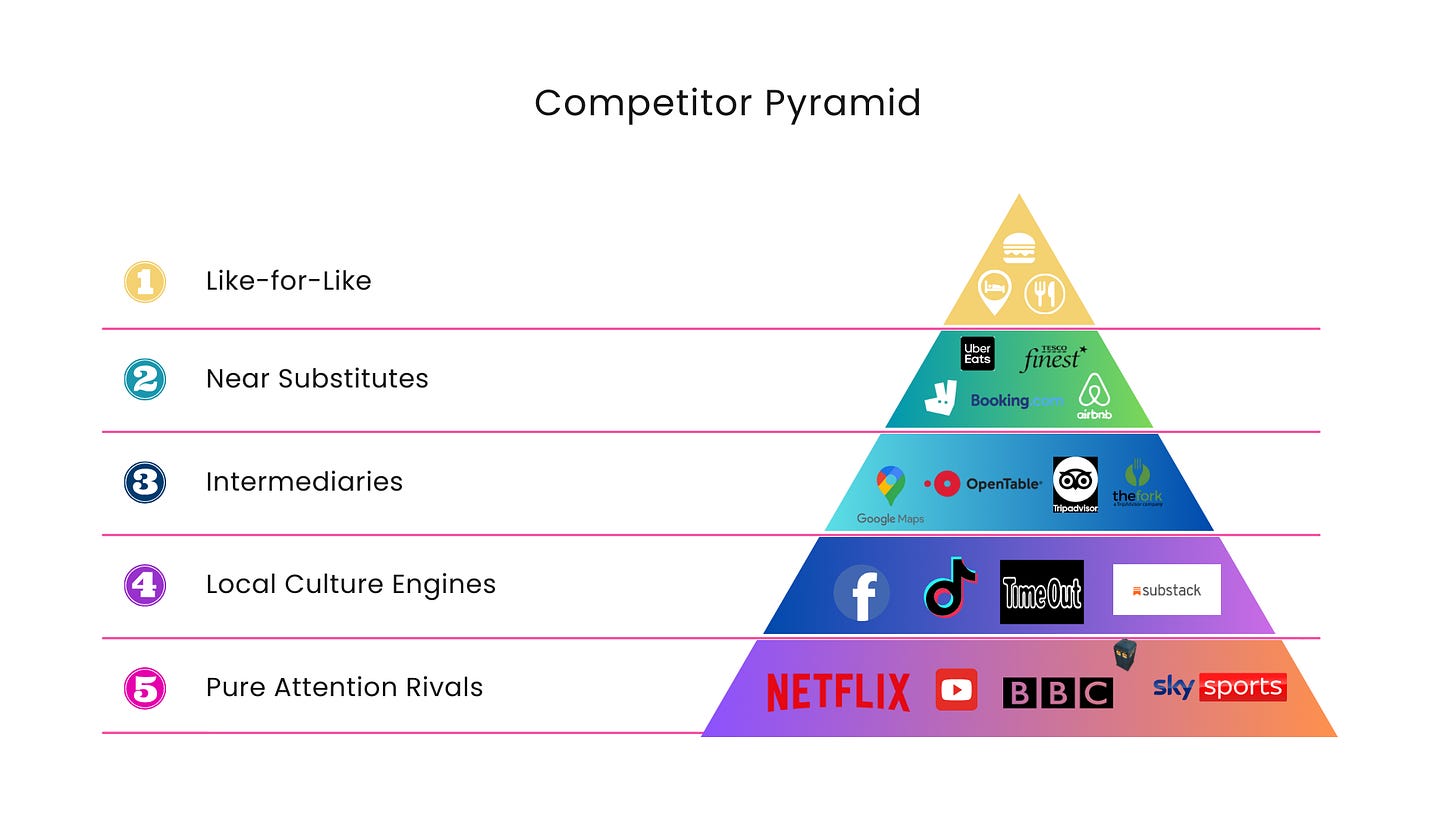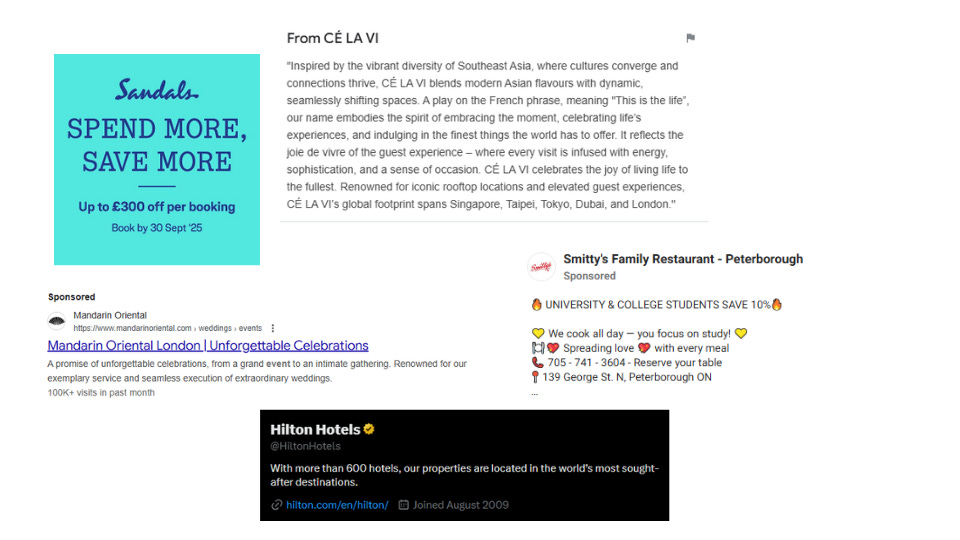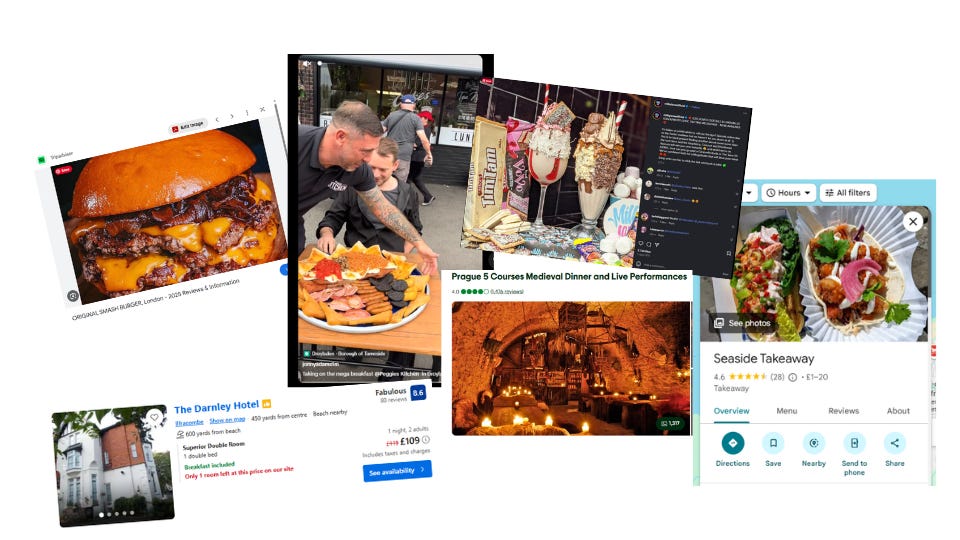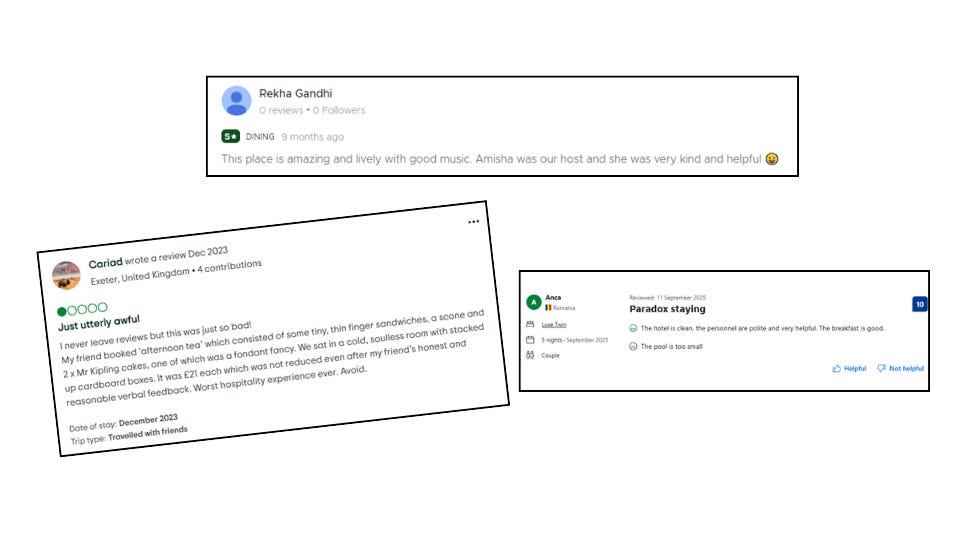📌 Content Differentiation Strategies That Actually Work
Learn how to stand out in hospitality marketing with content differentiation. This step-by-step guide provides practical steps you can start using today to attract and convert guests.
How do hotels compete when every post looks the same? How can restaurants hold their own when chains dominate the trends, and what makes hospitality marketing content feel different enough to be noticed in a crowded feed?
🌞 Hello and welcome to Hospitality Marketing Insight. I’m your host, Dawn Gribble, and this week we’ll explore how to cut through sameness, compete with chains, and create content that guests notice, trust, and act on.
📄 On the Menu
🎯 Identify Your Rivals
📑 Creating a Swipe File
🖼️ Curating Visuals
💬 Review Mining
🎞️ Mood Board Presentations
🧠 Extracting Insights from Reviews
🧐 Analysing the Data
✨ Creating Differentiation
🍍 Action Plan
Let’s Check In ☕
Share this issue with your team.
Marketing will pick up campaign ideas.
F&B can fine-tune menus using guest language.
Operations get service insights.
Guest Experience find better ways to reply to reviews.
👉 Everyone walks away with something they can use today.
🎯 Identify Your Rivals
Before you can stand out, you need to know exactly what and who you are up against. But your rivals might not be who you think they are. When most operators think about competition, they picture the venue next door. The bistro across the street, the hotel two doors down. In reality, your rivals stretch across five layers, competing for time, wallet, or attention.
At the very top of the pyramid are direct like-for-like rivals. These are your obvious competitors. The restaurant serving the same cuisine at the same price point. The hotel in the same postcode with a similar vibe.
Just beneath sit the Near Substitutes. For restaurants, this means guests weighing the options of takeaway apps, home cooking, or a movie night over dining out. For hotels, it’s serviced apartments, boutique rentals, or even staying with friends.
The middle of the pyramid belongs to intermediaries. Platforms like Google Maps, TripAdvisor, and OpenTable stand between you and the guest. They decide what appears first, set the benchmarks for “good,” and often capture the booking or review traffic themselves. If your content does not go beyond the basics shown on these listings such as hotel name, star rating, address, or phone number, guests have no reason to click through. At that point, you risk disappearing from their decision process.
Further down are the local culture engines. City guides, Facebook groups, TikTok creators, and neighbourhood newsletters. They do not just report on the scene. They set it. If you are absent here, the taste-makers are shaping demand without you.
The base of the pyramid is attention rivals. Entertainment, social media, and daily fatigue are pulling guests away. Your content must stand out immediately, or you lose them before they ever consider booking.
The pyramid shows your rivals are not just other venues. They are anything competing for a guest’s time, wallet, or attention. Smart operators design content that addresses every layer, then study how competitors present themselves to turn insight into action.
To stand out from the crowd, you need to know what the crowd looks like.#
🕵️♀️ Gather the Data
True differentiation is built on evidence, not guesswork. The stories you tell, the visuals you publish, and the guest language you highlight all come from data you have deliberately gathered.
This is where swipe files, mood boards, and review mining come in. They give you the raw material to see patterns, spot gaps, and decide how your content can stand apart.
Content Capture Tools
As anyone who’s ever worked in a kitchen knows, the right tools make all the difference. For capturing clippings I recommend the following
Windows users: Print Screen or Snipping Tool for quick screenshots.
Mac users: Built-in shortcuts (Shift + Command + 4 to capture a selected area, Shift + Command + 3 for the full screen).
Browser extensions: Tools like GoFullPage or Fireshot let you capture an entire web page in one click.
Save as PDF: Use your browser’s “Print to PDF” to keep full landing pages, ads, or emails.
Mobile users: Use your phone’s built-in screenshot function or a screen recording app to capture social posts, ads, and stories before they vanish.
File Organisation
Collecting examples of your rivals’ marketing efforts is only helpful if you can find them later.
Create a dedicated folder in Google Drive, Dropbox, or your preferred cloud storage.
Use a clear file naming convention: [Venue][Platform][Date]. Example: BistroCentral_Instagram_2025-09-05.
Keep a separate folder for your anti-swipe file so you do not mix up what to draw inspiration from with what to avoid.
For text and messaging examples, keep a master document or shared folder. A simple Google Doc with pasted examples and links works well. Keep a separate “anti-swipe file” to avoid mixing inspiration with poor practices.
If you want more power, tools like Zotero let you save full pages, add notes, and tag them — making it easy to remember why you saved an example and what stood out.
Here’s What You Should Explore
Landing Pages
Email Welcomes and Campaigns
Event Listings
Google Business Profiles and OTA Cards
Reels and Stories
Out-of-Home (OOH) Advertising
Printed Menus
PR Features
OTA and Delivery Apps e.g. Booking.com, Deliveroo
Local Press Native Ads
Be deliberate. Collecting everything drowns you in screenshots and tabs. Collecting the right things builds a focused reference that saves time and hones your content. The goal is not to hoard random clippings but to gather a set of examples you can actually learn from. To do that, you start by building a swipe file.
📑 Creating a Swipe File
A swipe file is your personal library of competitor content. It reveals where budgets are being spent, what content is driving engagement, and what falls flat so you don’t repeat it. Your objective is to capture messaging — the words, hooks, and structures your rivals use to win attention and influence decisions.
The Anti-Swipe File
Most swipe files only capture the good. But you learn just as much from what falls flat. The anti-swipe file is where you save examples that confuse, mislead, or fail to inform. It becomes a reference of what not to do, think poor menu design, cropped rooms, vague inclusions, robotic captions. Over time, this file is just as valuable as your inspiration library, because it keeps you from repeating mistakes that frustrate guests.
When building your swipe file, keep it concise and practical. Aim for three to five examples in each category so the library stays usable rather than overwhelming. Prioritise examples that have spend behind them, such as ads, promoted posts, or sponsored listings, since these show where competitors are betting their budgets.
Capture how each example is structured, the call to action it uses, and where it leads. The result is a focused collection you can return to again and again without drowning in clutter.
A swipe file captures the words, hooks, and structures your rivals rely on. A mood board goes further, showing the visuals, layouts, and creative choices that shape their style. Together, they give you both the language and the look of your category.
🖼️ Curating Visuals
Curating competitor visuals helps you decode the creative choices in your category. On their own, screenshots and clippings are just fragments; together, they reveal patterns in style, tone, and visual direction.
When you place captures side by side, you can see the “house style” of your market at a glance. Does everyone lean on glossy stock images? Are menus and promotions crowded with text? Do ads highlight people, places, or product close-ups?
You are not analysing deeply here, that comes later. The aim is simply to surface what your category looks and feels like right now so you can bring it to the table for discussion. A well-curated mood board should act as a visual map of the competitive landscape.
💬 Review Mining
Once you have mapped your rivals and gathered their messaging and design cues, the next step is to listen to what guests are saying. Reviews are a goldmine. They show you what people value, what frustrates them, and the exact words they use to describe the experience.
Collection Checklist
Airbnb or aparthotel listings
Private sources such as DMs and guest emails
By capturing guest language, you uncover both the wins and the losses. Wins tell you what to emphasise in your own messaging. Negative reviews reveal what hinders a booking. Fix those points in your own messaging, and you immediately stand out. And when you echo the phrases your customers already use, your copy immediately feels real and relatable.
The real value of review mining comes from how you use the insights. Surface the exact words guests rely on, both their praise and their pain points. Spot the decision blockers and unmet expectations that prevent bookings. Then build a bank of guest phrases you can reuse in menus, ads, and campaigns. When you weave their own language back into your content, it immediately feels more relevant and more persuasive.
🗝️ Join Me in the VIP Lounge 🔒
In the VIP Lounge, I’ll show you how to differentiate content that earns attention quickly, builds trust, and keeps you in the running even when attention is scarce
You can also ask questions in the member-only comments, where I’ll reply with practical, tactical advice, without the consulting fee.
Let’s get to work 👇







